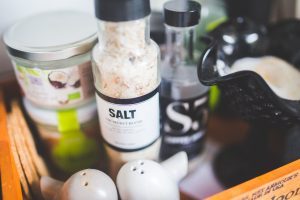 Sodium is necessary for regulation of blood pressure, nerve functioning, muscle contraction and regulating the volume of the blood, but you can get too much. If you cut out all the salt you sprinkled on meals, you might still have more sodium daily than what is actually healthy. Sodium is beneficial for the body, but many of the foods we eat have sodium chloride and other forms of sodium already added when food is packaged, bottled, canned or frozen.
Sodium is necessary for regulation of blood pressure, nerve functioning, muscle contraction and regulating the volume of the blood, but you can get too much. If you cut out all the salt you sprinkled on meals, you might still have more sodium daily than what is actually healthy. Sodium is beneficial for the body, but many of the foods we eat have sodium chloride and other forms of sodium already added when food is packaged, bottled, canned or frozen.
Why do manufacturers add sodium?
In the average American diet, more than 70% of the sodium comes from the commercial and manufacturing of food with less than 30% found naturally in food or sprinkled on at the table. It’s added for several reasons. One is for flavor, but it also extends shelf life and helps reduce the growth of microbes and preserve the food. That limits the potential for foodborne illnesses.
How much sodium do you need every day.
That answer varies. If you workout and sweat or live in a hot area and are out in the sun, you need more sodium to replace the sodium lost through perspiration. Your age, weight and sex are other variables. However, on the average, anyone older than 14 years old should limit their consumption of sodium to 2,300 mg per day or less or face the risk of health conditions like high blood pressure. If you have hypertension, reducing sodium intake to 1,500 mg per day is recommended.
Sodium is an acquired taste.
Like sugar, the more salt you put on something, the more your taste buds adapt to the higher intake. Reducing the amount of sodium you add slowly can make it easier and keep food palatable and delicious. Cutting out many of the highly processed manufactured foods can dramatically reduce the intake of sodium, plus lower the intake of other ingredients like refined flour and sugar.
- You can improve the taste of food without the salt shaker and also boost the nutrient content by adding herbs. Sprinkle on some basil instead and you’ll boost your memory, reduce strokes and lower your blood pressure.
- If you like spicy chili, put away that salt shaker and get creative. Adding cinnamon or cinnamon basil can bring out the flavor. Both also help lower, not raise blood pressure.
- When you eat prepackaged food, check the food labels for the number of milligrams of sodium per serving. The words salt, sodium and soda in the ingredients list are also a giveaway. MSG is high in sodium. It’s the acronym for monosodium glutamate.
- There are ways to reduce sodium if you’re on a budget and using canned vegetables. For instance, you can drain and rinse green beans if they have sodium added to reduce the sodium content.
For more information, contact us today at Iron Fit San Antonio
